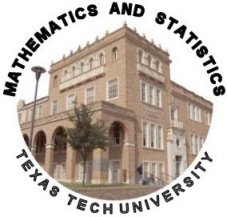Workshops for Students
Mathematical Models: Important Tools in the Study of Disease Control
Dr. Linda Allen, Horn Professor
Mathematical models for the spread of infectious diseases provide a framework for studying the progression of an epidemic.
In addition, mathematical models allow various intervention and disease control strategies to be tested before they are implemented. Models have been constructed for many diseases including influenza, HIV-AIDS, SARS, plague, West Nile virus, and Hantavirus. These models have been useful in testing drug therapies and vaccination and quarantine strategies. In this workshop, we will construct some simple mathematical models for the spread of an infectious disease and illustrate how the models can be used in the study of disease control.
The Mathematics of Juggling
Dr Ram Iyer, Associate Professor, and Dr. Arne Ledet, Associate Professor
In juggling, the balls follow distinctive patterns. These patterns can be described mathematically in several ways, for instance as strings of numbers or by means of directed graphs. We will explain these mathematical descriptions, and illustrate how they relate to the actual juggling.
Predator-Prey and Competing Populations
Dr. Sophia Jang, Associate Professor
This workshop will use computer simulations to study mathematical models of population interactions. We shall explore the cyclic behavior of the predator-prey interactions and of competition outcomes for two competing populations. We shall see when the predator and prey populations can coexist and when the predator will drive the prey population to extinction in a predator-prey system. We shall also examine which population can out compete the other population in a model of two competing populations.
Why Math? Careers and Academic Opportunities for Math Majors
Levi Johnson, Graduate Student
Just at Texas Tech University, there are more than ten different colleges and schools. Students can select majors ranging from English to architecture to political science. So, why would anyone choose to major in mathematics? How does a math degree distinguish someone from an engineering or science degree? How do math students compare on pre-professional tests like the LSAT or MCAT? This workshop will attempt to deal with these questions and more.
How to Kill a Zebra and Raise a Family
Dr. Clyde Martin, Horn Professor
The lions of Africa have a very formal arrangement in families and related lions. The questions that we will pose are related to how large a pride should be. We will ask such questions as: "Why aren't there 100 players on the field during a football game instead of 11? Why aren't football teams restricted to two players? Why doesn't a pride of lions have 100 members? Why don't lions live alone? We will try to understand the mathematics of these questions and then ask and answer the most important question: What kinds of problems can we study if we know mathematics?
Why is Statistics significant? A Two-Tale Talk
Dr. Alex Trindade, Associate Professor and Emily Powell
Tale I will be an overview of what statistics is, how statistics is present behind the scenes in every field of scientific endeavor, what statisticians do, and how to become a statistician. (Presented by Dr. Trindade.)
Tale II will consist of a presentation by a senior undergraduate student who will describe her work experience through an Honors Project on statistical simulation. (Presented by Emily Powell.)
What's Calculus Really All About
Dr. Brock Williams, Associate Professor
What's the big deal about calculus? Why do we need calculus anyway? Isn't algebra enough math for anybody? In this workshop we'll describe what calculus really is, why it's so much more powerful than algebra, and how we can solve the problems that arise in the real world. We'll also discuss the big ideas calculus students need to understand and how we can help them do so.
|

